Concept Note
Mangroves4Life: Community-Based Mangrove Restoration for Coastal Protection in the Sundarbans Region of Bangladesh
Lead Organization: SESDO (Social and Environmental Sustainable Development Organization)
Location: Village: Pasvemari, Union: Gabura, Upazila: Shyamnagar, District: Satkhira.
Duration: 2025–2030 (Phase 1 – 2025)
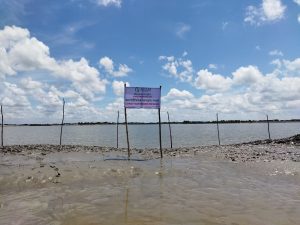
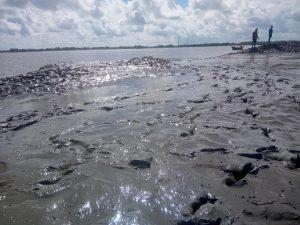
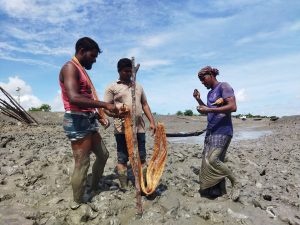
Background & Problem
The Sundarbans, is registered as a UNESCO World Heritage Site and a Ramsar Convention site. It is a place rich in natural environment with approximately 600,000 hectares of mangrove forests and wetlands, particularly Pasvemari village in Gabura Union, Shyamnagar Upazila, Satkhira District, is one of the most climate-vulnerable coastal regions in Bangladesh. Frequent cyclones, flooding, extreme climate threats, rising sea levels, and saltwater intrusion threaten Sundarbans ecosystem, livelihoods, biodiversity, youth employment and public health. Mangrove degradation has reduced natural coastal protection, leaving communities especially women and marginalized groups highly exposed to climate disasters.
Our Solution
Mangroves4Life applies the Community-Based Ecological Mangrove Restoration (CBEMR) method to restore degraded mangrove ecosystems while creating sustainable, women-led livelihoods. The project empowers youth and women in Gabura Union to combat climate change and protect the Sundarban ecosystem through mangrove restoration. This Community-Based initiative will empower women to drive long-term sustainability, enhance climate resilience, safeguard biodiversity, and create a community-driven model for grassroots climate action in the Sundarban. This model can be scaled across other coastal regions of Bangladesh.
Objectives
The project aims to create mangrove buffer zones, strengthen resilience and sustainable livelihoods through the following objectives:
- To create mangrove buffer zones that enhance coastal protection.
- To safeguard biodiversity from climate-induced disasters.
- To engage local communities in mangrove restoration.
- To promote sustainable, nature-based livelihoods and alternative income opportunities.
- To empower youth and women as leaders in climate resilience.
Key Activities
To achieve these objectives, the project will implement the following key activities:
- Site assessment, species zoning, and ecological restoration planning.
- Seed collection of 10 native mangrove species.
- Nursery establishment and training for coastal women.
- Community-based planting and monitoring.
- Capacity building on sustainable livelihoods linked to mangroves.
- Train 100 participants (especially women, youth, girls, and indigenous people) in CBEMR method and biodiversity conservation.
- Deploy youth-led teams to protect the Sundarban ecosystems and sustainable use of natural resources.
- Improving livelihoods through the promotion of kitchen gardens, organic vegetable farming, livestock, and sustainable agricultural practices.
- Conducting community-participation mangrove planting and environmental education mainly in the Sundarban coastal basin.
Expected Impacts (5 Years)
The project is expected to deliver measurable ecological, social, and climate benefits within five years, including:
- Ecological: Restored mangrove habitats, improved biodiversity, reduced coastal erosion. (Restore 20 hectares (100000 mangroves) of degraded mangroves, Establish 5 women-led nurseries).
- Social: 100 women gain livelihood security, improved disaster preparedness.
- Climate: Increased carbon sequestration, strengthened natural defenses against storms.
Partnership Opportunity
We welcome collaboration with donors and partners to support and scale this initiative. Priority areas for partnership include:
- Develop women-led mangrove nurseries to ensure a sustainable supply of seedlings.
- Implement large-scale mangrove planting and restoration to restore degraded coastal ecosystems.
- Promote sustainable livelihoods and alternative income sources for women, youth, and marginalized groups.
- Foster long-term community stewardship by building local leadership and ownership of restoration efforts.
By partnering with us, donors and collaborators will contribute directly to ecosystem restoration, biodiversity conservation, disaster risk reduction, and improved livelihoods in the Sundarbans region. Together, we can restore the Sundarbans, protect vulnerable coastal communities, and build a climate-resilient future for next generation.
Contact
Tapas Kumar Mollick
Founder & Executive Director
SESDO
Email: sesdobd@gmail.com
WhatsApp: +8801725351685
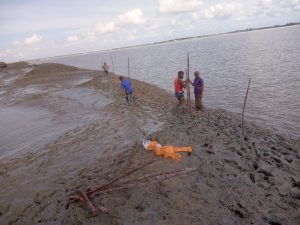
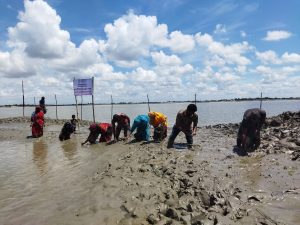
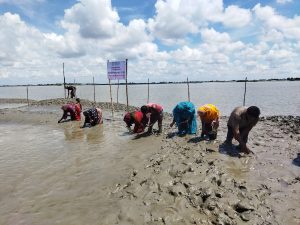
Project Documentation
Project Overview
- Project Title: Mangroves4Life: Community-Based Mangrove Restoration for Coastal Protection in the Sundarbans Region of Bangladesh
- Organization: SESDO (Social and Environmental Sustainable Development Organization)
- Location: Pasvemari Village, Gabura Union, Shyamnagar, Satkhira District, Bangladesh
- Project Duration: 2025 to 2030
- Methodology: CBEMR (Community-Based Ecological Mangrove Restoration)
- Funding Source: Sourcing
Technical Records
Site Information
- GPS Coordinates: 22°14’03″N 89°18’19″E
- Site Size (ha): 0.54 ha
- Type of Land: River char, degraded mangrove, and embankment area
- Previous Land Use: Mangrove Forest
- Tidal & Salinity Conditions: Tidal zone is low to mid & salinity conditions are suitable for mangrove growth.
Nursery Development
- Nursery Owner: Rozina Begum
- Location: Pasvemari Village, Gabura Union.
- Number of Species Cultivated: 10
- Seed Collection Month & Source Location: May to July, River.
- Preparation Method: CBEMR
- Seed Count: 10 number of species
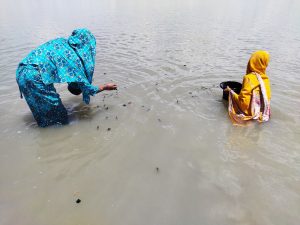
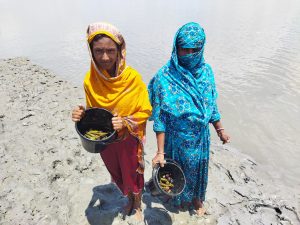
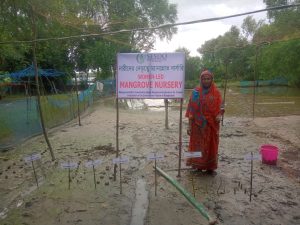
Planting/Assisted Natural Regeneration Activities
- Planting Date: 15 August
- Species: 6 local mangrove species
- Total seeds planted: 2700
- Planting Layout: Cluster & gap filling
- Community Participants: 30 Participants (20 women, 5 youth, 2 girls & 3 Indigenous)
Community & Stakeholder Engagement
- Community Meetings: 8 community meetings (2024–2025)
- Partnerships: Coastal communities, women group, youth group, schools, local government, and forest department.
- Inclusion: Women, Indigenous, girls, and youth participation
Lessons Learned & Next Steps
Challenges Faced
- The primary challenge was limited funding, which restricted the scale of nursery development, sapling procurement, and expansion of restoration sites.
- Despite strong community interest and commitment, financial constraints limited the ability to provide training, expand sustainable livelihood options, and establish wider site protection measures.
Solutions Tried
- Mobilized community volunteers to contribute labor and local knowledge, reducing costs for plantation and site monitoring.
- Collected and prepared local mangrove seeds directly from the river to minimize procurement expenses.
- Established small-scale women-led nurseries with limited resources to ensure an initial supply of saplings.
- Focused on priority restoration areas first rather than spreading too thin across larger sites.
- Built partnerships and networks with local stakeholders to share knowledge, materials, and technical support where possible.
Next Steps
- Expand 5 women-led nurseries
- Increase training for 100 participants on CBEMR techniques
- Scale up restoration sites (target: 20 ha by 2030)
- Develop long-term community stewardship agreements
- Strengthen community-based early warning systems
- Promote sustainable livelihoods and alternative income sources
- Empower women and marginalized groups
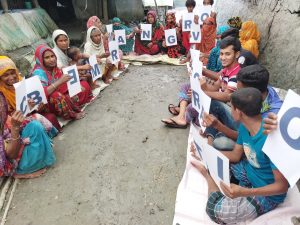
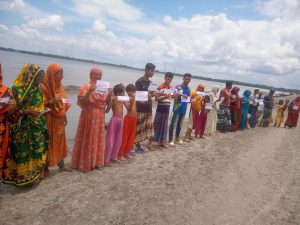
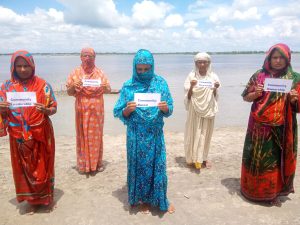
Project Proposal
Title:
Mangroves4Life: Community-Based Mangrove Restoration for Coastal Protection in the Sundarbans Region of Bangladesh
Summary:
The Sundarbans, is registered as a UNESCO World Heritage Site and a Ramsar Convention site. It is a place rich in natural environment with approximately 600,000 hectares of mangrove forests and wetlands, particularly Pasvemari village in Gabura Union, Shyamnagar Upazila, Satkhira District, is one of the most climate-vulnerable coastal regions in Bangladesh. Frequent cyclones, flooding, extreme climate threats, rising sea levels, and saltwater intrusion threaten Sundarbans ecosystem, livelihoods, biodiversity, youth employment and public health.
The “Mangroves4Life: Community-Based Mangrove Restoration for Coastal Protection in the Sundarbans Region of Bangladesh” project that empowers youth and women in Gabura Union to combat climate change and protect the Sundarban ecosystem through mangrove restoration. This Community-Based initiative will empower women to drive long-term sustainability, enhance climate resilience, safeguard biodiversity, and create a community-driven model for grassroots climate action in the Sundarban.
Specific objectives of the project:
- To create mangrove buffer zones that enhance coastal protection.
- To safeguard biodiversity from climate-induced disasters.
- To engage local communities in mangrove restoration.
- To promote sustainable, nature-based livelihoods and alternative income opportunities.
- To empower youth and women as leaders in climate resilience.
Goal:
The long-term goal of the project is to protect the coastal communities and biodiversity conservation from the natural disasters and increase the mangrove coverage through planting and regenerating 100000 mangrove together with local people in the Sundarbans region in terms of climate change adaptation and mitigation. Mangroves around the project site were once abundant but are now under threat from climate change and human activities. This project addresses urgent climate threats while creating a new generation of environmental leaders. By restoring natural coastal defenses, we protect biodiversity, support sustainable livelihoods, and strengthen the resilience of frontline communities.
Activities:
- Train 100 participants (especially women, youth, girls, and indigenous people) in CBEMR method and biodiversity conservation.
- Deploy youth-led teams to protect the Sundarban ecosystems and sustainable use of natural resources.
- Improving livelihoods through the promotion of kitchen gardens, organic vegetable farming, livestock, and sustainable agricultural practices.
- Conducting community-participation mangrove planting and environmental education mainly in the Sundarban coastal basin.
Outcome:
- Each member of the youth group will gain a deeper understanding of the local natural environment, mangrove ecosystem systems, biodiversity, and the importance of environmental conservation.
- Increased alternative income and reduced dependency on mangrove ecosystems
- Degraded mangrove restoration and increased community awareness of mangrove conservation
- Elevated youth leadership and skills training in youth entrepreneurship
Site:
Village: Pasvemari, Union: Gabura, Upazila: Shyamnagar, District: Satkhira.
Target Communities:
Women, youth, girls, indigenous people, person with disabilities and marginalized groups in disaster-prone coastal villages, particularly those communities affected by frequent cyclones and environmental degradation. Especially Local farmers, fishers, and honey collectors.
SDGs:
1, 2, 4, 5, 6, 8, 13, 14, 15, 17
Project type:
Community/field-based implementation
Landscape type:
Landscape, Seascape
Model:
CBEMR
Organization:
SESDO (Social and Environmental Sustainable Development Organization)
Project Duration:
2025 to 2030
Partnership and stakeholders:
The Mangroves4Life initiative will be implemented through collaboration with coastal community members, community organizations, youth and women’s groups, indigenous groups, local government (Gabura Union Parishad), Department of Environment (DoE), Department of Forest (DoF), Department of Agricultural Extension (DAE), schools and NGOs.
Sustainability:
Planted mangroves will prevent unwanted migration of coastal people by reducing river bank erosion and protect the community from other natural calamities. So, these mangroves will have social impacts as well as environmental impacts. These mangroves will contribute to reduce the poverty of the coastal people. Once the community will get benefit from it, they will conserve those mangroves for their own betterment.
- Cooperative-based ownership of enterprises
- Capacity building for long-term self-reliance
- Integration with government and donor programs
Long-Term Impact:
- Youth & Community Empowerment: Continuous environmental leadership.
- Integration with Local Institutions: Ensures long-term impact.
- Sustainable Livelihoods: Promotes alternative income source.
- Ongoing Environmental Practices: Maintained by community.
- Financial Sustainability: Potential eco-tourism, product sales.
- Policy Advocacy: Supports institutional change.
Mangroves4Life: Funding Menu
Community-Based Mangrove Restoration for Coastal Protection
Your contribution directly restores mangroves, empowers coastal women, and builds climate resilience. Below are sample unit costs to support specific activities of the project:
| Category | Activity / Item | Details | Unit Cost (USD) |
| Capacity Building & Training | Workshop on CBEMR & Climate Resilience | 30 Participants + expert ($50 food + $50 honorarium) per session | $100 |
| Awareness Program for School Students & community members | Awareness sessions, posters, banners, eco-education materials | $150 | |
| Mangrove Restoration Activities | Women-led Small Nursery | Establishment & operation (training, tools, maintenance) per nursery | $200 |
| Seed Collection from River | 1,000 mangrove seeds collected & prepared for germination | $200 | |
| Sapling Preparation in Nurseries | Raising 1,000 saplings from collected seeds | $300 | |
| Site Preparation & Plantation | Preparing land and planting 1,000 saplings | $300 | |
| Livelihood Activities | Kitchen Garden | Household-level garden with seeds & tools per family | $100 |
| Poultry (5 hens) | Starter pack for family livelihood | $25 | |
| Poultry (5 ducks) | Starter pack for family livelihood | $25 | |
| Small Livestock (1 sheep) | Women-led household income generation | $100 | |
| Monitoring & Evaluation (M&E) | Monitoring, Guarding & Maintenance, Community-led care for 1,000 saplings (first year) | Survival surveys, growth monitoring, community reporting
|
$200 |
| Project Coordination & Logistics | Field Team Support & Transport (1st year) | 4 events × $50 | $200 |
Every contribution counts. For example, $25 can support a starter pack for family livelihood, $200 can establish a women-led nursery, while $1,000 can support a full cycle of 1,000 saplings from seed to plantation.
